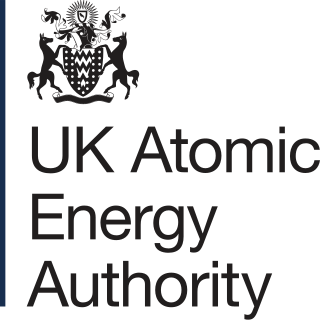
Sellafield, formerly known as Windscale, is a large multi-function nuclear site close to Seascale on the coast of Cumbria, England. As of August 2022, primary activities are nuclear waste processing and storage and nuclear decommissioning. Former activities included nuclear power generation from 1956 to 2003, and nuclear fuel reprocessing from 1952 to 2022.

The Atomic Energy Research Establishment (AERE) was the main centre for atomic energy research and development in the United Kingdom from 1946 to the 1990s. It was created, owned and funded by the British Government.

The Atomic Weapons Establishment (AWE) is a United Kingdom Ministry of Defence research facility responsible for the design, manufacture and support of warheads for the UK's nuclear weapons. It is the successor to the Atomic Weapons Research Establishment (AWRE) with its main site on the former RAF Aldermaston and has major facilities at Burghfield, Blacknest and RNAD Coulport.

Great British Nuclear (GBN), formerly British Nuclear Fuels Ltd (BNFL), is a nuclear energy and fuels company owned by the UK Government. It is a non-departmental public body sponsored by the Department for Energy Security and Net Zero.

The United Kingdom Atomic Energy Authority is a UK government research organisation responsible for the development of fusion energy. It is an executive non-departmental public body of the Department for Energy Security and Net Zero (DESNZ).

Dounreay is a small settlement and the site of two large nuclear establishments on the north coast of Caithness in the Highland area of Scotland. It is on the A836 road nine miles west of Thurso.

Chapelcross nuclear power station is a former Magnox nuclear power station undergoing decommissioning. It is located in Annan in Dumfries and Galloway in southwest Scotland, and was in operation from 1959 to 2004. It was the sister plant to the Calder Hall nuclear power station plant in Cumbria, England; both were commissioned and originally operated by the United Kingdom Atomic Energy Authority. The primary purpose of both plants was to produce weapons-grade plutonium for the UK's nuclear weapons programme, but they also generated electrical power for the National Grid. Later in the reactors' lifecycle, as the UK slowed the development of the nuclear deterrent as the cold war came to a close, power production became the primary goal of reactor operation.

The Electricity Act 1947 was an act of the Parliament of the United Kingdom which nationalised, or bought into state control, the electricity supply industry in Great Britain. It established a central authority called the British Electricity Authority (BEA) to own and operate all public electricity generation and transmission facilities and created 14 area electricity boards with a duty to acquire bulk supplies of electricity from the central authority and to distribute and sell electricity economically and efficiently to industrial, commercial and domestic consumers. It vested 505 separate local authority and company owned electricity undertakings in the BEA with effect from 1 April 1948. The Electricity Act 1947 is one of a number of acts promulgated by the post-war Labour government to nationalise elements of the UK’s industrial infrastructure; other acts include the Coal Industry Nationalisation Act 1946; Transport Act 1947 ; Gas Act 1948; and Iron and Steel Act 1949.
Nuclear Electric was a nuclear power generation company in the United Kingdom. It was formed in 1990 as part of the privatisation process of the UK Electricity Supply Industry.
Gilbert Ronald Bainbridge (1925–2003) was a British nuclear physicist, engineer and farmer.

Magnox Ltd was a wholly-owned subsidiary of the Nuclear Decommissioning Authority (NDA), responsible for the safe decommissioning of 12 British nuclear sites. Originally created for the management of Magnox nuclear reactors, it went through various forms of organisation throughout privatisation of the nuclear industry, until coming into NDA ownership in 2019.

The Electricity Act 1989 provided for the privatisation of the electricity supply industry in Great Britain, by replacing the Central Electricity Generating Board in England and Wales and by restructuring the South of Scotland Electricity Board and the North of Scotland Hydro-Electric Board. The Act also established a licensing regime and a regulator for the industry called the Office of Electricity Regulation (OFFER), which has since become the Office of Gas and Electricity Markets (OFGEM).

Nuclear Non-Proliferation Act of 1978, 22 U.S.C. § 3201, is a United States federal law declaring that nuclear explosive devices pose a perilous threat to the security interests of the United States. The law restricts U.S. export of civil nuclear programs to other nations.

Sir William Leonard Owen was a British civil engineer and nuclear engineer. As Director of Engineering at the British Atomic Energy Project, he oversaw the construction of the Springfields Chemical and Fuel Element Plants, the Windscale Piles, Windscale plutonium extraction plant, Capenhurst gaseous diffusion plant and the Calder Hall nuclear power station.

The Electricity (Supply) Act 1926 was an Act of the Parliament of the United Kingdom which amended the law on the supply of electricity. Its long title is: ‘An Act to amend the law with respect to the supply of electricity’. This Act was construed as one with the Electricity (Supply) Acts 1882 to 1922, and was cited as the Electricity (Supply) Acts 1882 to 1926. It established a statutory body, the Central Electricity Board (CEB), ‘with the duty of supplying electricity to authorised undertakers’ and to ‘appoint consultative technical committees’. It provided for the Electricity Commissioners to prepare and transmit to the CEB ‘electricity schemes’ for relevant areas, and which identified the most efficient ‘selected’ generating stations which were to be used to generate electricity for the Board. The Act provided for ‘main transmission line’ interconnections between selected stations and undertakings; and to standardise the frequency of generation; and other purposes. The provisions of the Act enabled the construction of the National Grid.
Sir John McGregor Hill, was a British nuclear physicist who was chairman of the UK Atomic Energy Authority for 14 years.

The Atomic Energy Authority Act 1954 is an Act of the Parliament of the United Kingdom which established the United Kingdom Atomic Energy Authority with powers to produce, use and dispose of atomic energy and to carry out research into this and related matters.

The Atomic Energy Authority Act 1959 is an Act of the Parliament of the United Kingdom which amended and extended the constitution and powers of the United Kingdom Atomic Energy Authority.

The Electricity Act 2003 is an Act of the Parliament of the United Kingdom which facilitated the Government's response to the financial difficulties of British Energy.

Calder Hall Nuclear Power Station is a former Magnox nuclear power station at Sellafield in Cumbria in North West England. Calder Hall was the world's first full-scale commercial nuclear power station to enter operation, and was the sister plant to the Chapelcross plant in Scotland. Both were commissioned and originally operated by the United Kingdom Atomic Energy Authority. The primary purpose of both plants was to produce weapons-grade plutonium for the UK's nuclear weapons programme, but they also generated electrical power for the National Grid.













